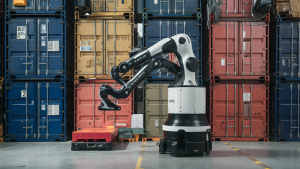Amazon’s robot workforce more than doubles in three years

Amazon has significantly increased the number of robots working in its fulfilment centers, with the US tech and e-commerce giant also claiming to be the world’s largest manufacturer of industrial robots.
A report from Business Insider has indicated robot numbers have spiked from 350,000 in 2021 to 750,000 by the middle of 2023.
Amazon has several different robots at its disposal to deploy as part of its relentless and high-volume operations to sort customer orders. Robotic arms, called Robin and Sparrow, were brought into service at the company’s Robotics Innovation Hub, near Boston after the full design and manufacture process was completed in-house.
Robin was described as “one of the most complex stationary robot arm systems Amazon has ever built”, assisting in different stages to scan and sort packages for dispatch, whilst Sparrow is a state-of-the-art robot that streamlines the fulfilment process.
The company also benefits from the Proteus and Hercules robot models which can move containers, complemented by its Sequoia robotic system which goes further to sort and shift containers around to reduce the physical impact on human staff. These machines are said to reduce strain on employees’ bodies, including repetitive movements such as bending and stretching.
Amazon delivers on productivity with robots proving to be a solutionAmazon has stated Sequoia increases productivity by identifying and storing inventory at a rate of 75% faster than employees can at present, meaning products can be listed quicker on Amazon’s online marketplace. Once an order is placed, Sequoia can then save up to 25% of the time it takes for an order to be processed, acting as a catalyst for better lead times for shipping.
Recorded incident rates and ‘lost-time incident rates’ (how often injuries happen at work and subsequent time away from work) fell by 15% and 18%, respectively, at Amazon’s robotic sites in 2022, compared to non-robotic plants.
Scott Dresser, VP of Amazon Robotics commented on how robots are creating opportunities for employees, challenging perceptions of the threat posed to workers by artificial intelligence.
“Ensuring robotics are collaborative and support employees is central to how we design or deploy systems like Sequoia and Digit” he said.
“Over the last 10 years, we’ve rolled out hundreds of thousands of robotics systems while also creating hundreds of thousands of new jobs within our operations. This includes 700 categories of new job types, in skilled roles, which didn’t exist within the company beforehand.”
According to the company’s 2023 annual report, Amazon’s growing legion of robots is still much smaller than the total number of employees, which stands at 1.525 million (full-time and part-time workforce combined).
The company has axed jobs within Amazon Web Services this year, despite an overall revenue figure of $143.3 billion for the first three months of the year which is a 13% increase from last year. Amazon was expected to reach $142.65b but operating income surged more than 200%, bringing this metric to $15.3 billion.
Image credit: Ideogram
The post Amazon’s robot workforce more than doubles in three years appeared first on ReadWrite.
